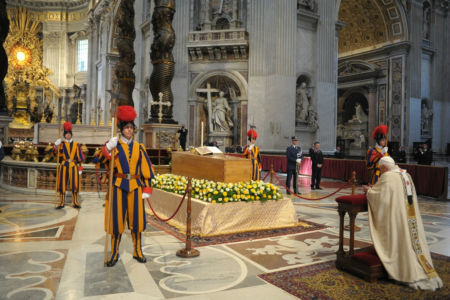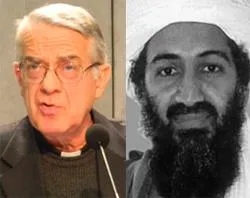Monsignor Vincent Topper, the oldest and longest-serving priest in the Diocese of Harrisburg, today celebrates the 75th anniversary of his ordination to the priesthood with a Mass and dinner at St. Catherine Laboure Parish in Harrisburg, where he lives and works. Msgr Topper is 98 years old and continues to be active in the parish: celebrating Mass and attending parish functions. Just a few weeks ago, at the parish's 40 Hours closing, Msgr Topper was the celebrant.
Msgr. Topper has been pastor at four parishes and assistant pastor at two. In 1936, Msgr. helped to found the parish of Holy Infant in York Haven. Among his other assignments were: assistant pastor at Our Lady of Mount Carmel Church, Mount Carmel, from 1943 to 1948; pastor at St. Joseph Church, Milton, from 1950 to 1957; and pastor of St. Columba Church, Bloomsburg, from 1957 to 1963. He retired in 1977 from Saint Joseph Church in Springettsbury Township.
During Monsignor Topper's lifetime, there have been nine popes of the Catholic Church and eight bishops of the Diocese of Harrisburg. He became interested in the priesthood while he was in the second grade.
At 98, the native of Hanover is the the oldest and longest-serving Catholic priest in our 15-county Diocese.
Bishop Joseph P. McFadden and Archabbot Douglas R. Nowicki of St. Vincent Archabbey are expected at Tuesday's celebration at St. Catherine Laboure.
Back in 2006, the York Daily Record did a profile on Msgr. Topper. In that article, he discussed how the Church and Catholics have changed during his, now, 75 years of service as a priest. That article follows:
Jun 29, 2006 — In 1936, a Hanover native christened Vincent Topper helped found a little mission church across the Susquehanna River from Bainbridge. Seventy years later, counting on his age-spotted fingers, Topper still remembers exactly how many Catholic families then lived in and nearby Saginaw, Mount Wolf, Manchester and York Haven: Just enough to fill nine pews.
"It was the days of the Great Depression," said Msgr. Topper, who takes his time telling stories. "No cars back then. So I would go and pick them up and bring them back home."
The nine-pew mission later became Holy Infant Church in York Haven. Today, the parish is home to more than 1,600 Catholics. Topper carries the title "monsignor" and, pushing 94, [now approaching 99] is the oldest and longest-serving priest in the 15-county Diocese of Harrisburg.
The tall, balding clergyman seems surprised by that fact. After serving as pastor at four parishes and as assistant pastor at two, Topper expected to die not long after his retirement in 1977 from St. Joseph Church in Springettsbury Township, he said. His mother and father died young, as did several siblings. Instead, the math whiz spent 10 years as diocesan auditor, then substituted for vacationing or ill clergy at parishes around the diocese. He continues to celebrate Mass most Sundays at St. Catherine Labouré Parish in Harrisburg, where he shares a two-story residence with other priests.
"Haven't died yet," he said matter-of-factly. In relatively good health, he recently passed a physical that enables him to keep driving, Topper said. His memory is long-armed, recalling nine popes and eight bishops worth of Catholic Church history. Catholics have multiplied in the region since Topper's first priestly assignment took him to St. Mary's Church in York. His early assignments were small enough for him to know and visit everyone in the parish. "If you weren't in church on Sunday, I was in your home on Monday," he said.
By 1963, when he arrived at St. Joseph Church, visiting parishioners wasn't as easy. There were too many for him to make it to every home. More often, no one answered the doorbell because both parents were working. "Every place you go, you get to love the people," he said. "The joy of the priesthood is the love you have for the people and the love the people have for you."
Msgr. Topper laments how fewer parishioners revere the "beauty and sacredness" of the Mass today. "When you watch them going to Communion and watch how they dress at times, you wonder if they truly believe that's the Body and Blood of Christ." Partly to blame is the decline of religious education, Msgr. said, who founded St. Joseph School in Springettsbury Township and several other schools. "I always made sure the children got a Catholic education - that determines the way people live. That's the problem today. You can't say God in school. We're raising little pagans."
Msgr. Topper received a thoroughly Catholic education, skipping several grades and graduating early. As a young boy, he attended Mass daily and twice on Sundays with his mother. His younger sister, Judy McKim, said family is dear to him. "I can't get over - for a man his age - how active he is," said McKim, of Conewago Township, Adams County. Msgr. Topper certainly doesn't sit still for long.
He's taken 49 cruises since retiring. In August [of 2006], he headed to Alaska, and, in January, the Panama Canal. "I'm still happy," he said.
Reach Melissa Nann Burke at 771-2024 or mburke@ydr.com
MONSIGNOR TOPPER
Name: Vincent Topper
Born: 1912
Raised in: Hanover
Education: St. Vincent Seminary in Latrobe
Ordained:1936
Lives: at St. Catherine Labouré Church in Harrisburg
Retired: 1977




























